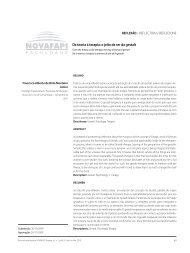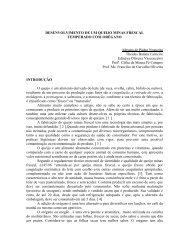Untitled - Novafapi
Untitled - Novafapi
Untitled - Novafapi
Create successful ePaper yourself
Turn your PDF publications into a flip-book with our unique Google optimized e-Paper software.
60<br />
ARTICLE CATEGORIES<br />
The Interdisciplinary Magazine publishes original articles, reviews,<br />
case studies, and also a student’s page, all this in the areas of health, human<br />
sciences and technology.<br />
Original articles: contributions destined to reveal results of new<br />
research. They are typewritten (using New Roman Times, #12) and printed<br />
on sheets of A4 sized (210 X 297 mm) paper, double spaced, with an upper<br />
left margin of 3.0 cm., and a lower right one of 2.0 cm. The original articles<br />
are at least 15 pages long, and at most 20 pages (including black and<br />
white illustrations, graphics, charts, photographs etc.) The charts and figures<br />
should be limited to five per group. Figures will be accepted, as long<br />
as they do not repeat data contained in the tables. It is recommended that<br />
the number of bibliographic references be twenty at most. The structure<br />
is conventional and is made up of an introduction, methodology, results,<br />
discussion and final conclusions.<br />
Reviews: systemized critical evaluations of scientific literature or<br />
opinions about certain subjects, with conclusions. The procedures adopted<br />
and the delimitation of the theme should be included. Its length is<br />
limited to fifteen pages.<br />
Original case studies: evaluated studies, or brief notes on research<br />
containing new and relevant subjects, they should follow the same norms<br />
as the original articles and are limited to five pages.<br />
The Student Page: dedicated to publishing articles developed by<br />
undergraduate students. These articles will have footnotes written by supervising<br />
professors. Their presentations follow the same norms as those<br />
demanded by the original articles, limited to five pages.<br />
All manuscripts will be turned in with an information sheet which<br />
will have the names of the authors, their academic backgrounds, employers,<br />
current positions, complete addresses and e-mails. One of the authors<br />
will take responsibility for any needed correspondence.<br />
Once the article is accepted for publication, it is with the condition<br />
that the copyright belongs exclusively to the magazine, (see attachment).<br />
The papers will be evaluated by the Editorial Council, and the Publishing<br />
Commission. The articles that are rejected will not be returned. The<br />
authors will receive a written explanation for the refusal.<br />
INTERDISCIPLINARY MAGAZINE - NORMS FOR PUBLICATION<br />
All concepts, ideas, and prejudices contained in the publications are<br />
the sole responsibility of its authors.<br />
In research involving persons, the authors should clearly state<br />
whether or not their project was approved by the Research Ethics Committee<br />
(CEP) It is also necessary to show clearly that the participants involved<br />
give their total consent, in accordance with resolution number 196 of the<br />
National Health Council of October 10, 1996.<br />
THE FORM AND PREPARATION OF THE MANUSCRIPT<br />
The Interdisciplinary Magazine recommends that the papers follow<br />
the orientations of the norms of the ABNT to make a list of references and<br />
indicate them together with the quotes.<br />
THE MANUSCRIPTS<br />
Three copies of the manuscript should be printed, and one put on<br />
CD with an archive developed on the MS WORD TEXT EDITOR.<br />
The Identification Page: title and subtitle of the article with a maximum<br />
of fifteen words, concise, though informative, in three languages<br />
(Portuguese, English and Spanish);with the name(s) of the author(s), six<br />
maximum, their university status, position(s), the name of the institution<br />
the work should be attributed to, city, state, complete address, including<br />
the e-mail of the researcher responsible for the group.<br />
The Abstracts and Key words: the abstract, written in the three<br />
languages mentioned above, should contain one hundred to two hundred<br />
words, be single spaced, stating the objective of the research, methodology,<br />
along with the main results and conclusions. The newest and most<br />
important aspects of the study should be emphasized. Underneath the<br />
abstract should be three to five keywords related to the theme. The three<br />
abstracts will be presented in sequence on the first page, including titles<br />
and keywords in their respective languages.<br />
The Illustrations: Charts should be consecutively numbered using<br />
algorisms, in the order which they are mentioned in the text, charts use<br />
only one set of numerations for the whole text. The same should be done<br />
for any images (Photographs, designs, graphics, etc) they are to follow the<br />
same rules as mentioned for charts.<br />
The Footnotes: should be mentioned in alphabetical order, appe




